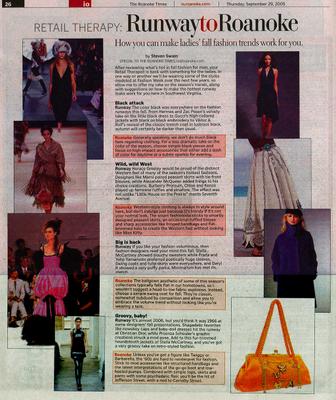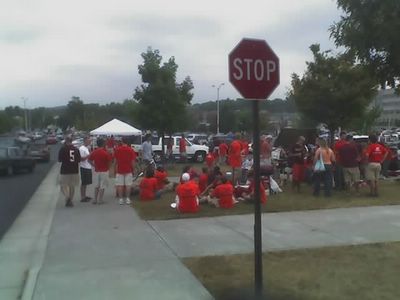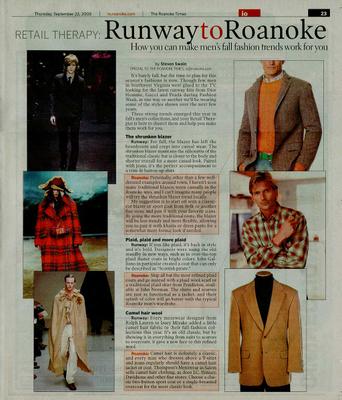By WARREN ST. JOHN
A PERSON can run out of fingers trying to count how many years it has been since the world saw - or at least took note of - the Spin Doctors. But think on the name hard enough and that song, their monster hit "Two Princes," from 1993, will probably bore its way out of your memory with the relentlessness of a dental drill:
"If you - want to be my baby, just go ahead now.
"And if you - want to tell me maybe, just go ahead now."
You probably know the rest.
Eric Schenkman, the guitar player for the Spin Doctors, knows what people think of when they think of his band, and if he forgets, usually someone will remind him, like a customs agent who checked his passport recently: "He said, 'Hey - you were in that 90's band,' " Mr. Schenkman said, seeming more amused than annoyed.
That 90's band. Well, yes and no.
The Spin Doctors are back. Or at least they're trying like crazy to come back. Last week the original members of the band - which started playing in the basements of fraternity houses at Columbia and N.Y.U. in the late 1980's, dominated the rootsy downtown club scene and then zoomed to international fame in 1993 with their album "Pocket Full of Kryptonite" - released a new album, their first in 11 years, "Nice Talking to Me," on a small label called Ruff Nation.
But careers undone by a decade or so of bad decisions and bad luck aren't resurrected overnight.
Over a café con leche at a Cuban restaurant on West 14th Street in Manhattan, Chris Barron, the rubbery, cheerful frontman known to those who remember the Spin Doctors as the bearded guy wearing the ski cap with ear flaps in the "Two Princes" video, said a lot went down in that decade. "It's a story of rags to riches to rags," Mr. Barron said. He took a sip of his coffee. "Hopefully to riches."
To the public the Spin Doctors may have seemed overnight sensations. But the band didn't feel that way. For years the group played around New York, at downtown clubs like the Continental Divide, Nightingales and Wetlands, sharing the bill with bands like Blues Traveler and the Surreal McCoys.
Mr. Barron, 37, grew up in Princeton, N.J., and came to New York with just $100 in his pocket after dropping out of Bennington. He said he remembers trudging equipment up the stairs of a five-floor walk-up with Mr. Schenkman in those days, when the band was writing the songs that would eventually become its smash record.
"We just all had the same sense of rhythm, and there was a feeling that it was more than four guys playing," he said. "That always felt like magic."
In 1991 the band signed a deal with Epic Records for $250,000, "an unimaginable sum," Mr. Barron said. The record came out to little notice, and the band hit the road to promote it.
Months into the tour the album still languished, and executives at Epic, convinced the album contained no hits, told the band to come back to New York to work on a second record. But Aaron Comess, 37, the drummer of the Spin Doctors, said the band had faith in its record and decided to keep touring.
After a year and a half on the road, the band got word that a radio station in Vermont was playing "Two Princes" regularly. With cheerful melodies that contrasted with the angst-ridden music of Nirvana and other grunge bands at the time, "Pocket Full of Kryptonite" soon took off. The album went on to sell an astonishing five million copies, reaching triple platinum.
Mr. Barron said he remembered going to an A.T.M. in those days and being puzzled to find that his balance was over $5,000: a bank error, he assumed. A couple of weeks later his balance exceeded $11,000. He called his accountant, who explained that the increase in finances came from royalties for the band's album.
Success cut both ways. The band began to get knocked down by the music media, which found the Spin Doctors, and in particular the song "Two Princes," a little too happy. (VH1 included the tune on its list of the "50 Most Awesomely Bad Songs Ever," tucked between "Sunglasses at Night" and "Cotton Eye Joe.")
"We had so much success we were overexposed," Mr. Barron said. "People were saying: 'I've heard this song forty thousand million times. Not again!' "
The band was getting a little sick of itself as well. Mr. Barron and Mr. Schenkman were arguing, particularly about the band's next record, which Mr. Schenkman thought was half-baked. With the band stressed and exhausted from touring, Mr. Barron said that even small disagreements broke out into big arguments.
"We were four guys who fundamentally loved each other but who didn't know how to resolve simple conflicts," he said.
On Labor Day 1993, while the band was touring to promote its second album, "Turn It Upside Down," Mr. Schenkman walked off stage from a concert in Berkeley, Calif., and left the band. He and Mr. Barron wouldn't speak for seven years.
Asked why he left, Mr. Schenkman, 41, said: "I'm still kind of wondering. I left without knowing exactly why."
The Spin Doctors found a replacement guitarist to complete their tour, but the album never caught on like "Pocket Full of Kryptonite." Still, they opened for the Rolling Stones in the United States and South America. In his mid-20's Mr. Barron had the thrill of hanging out with the Stones between sets in their "tuning room."
"I never saw anyone tuning anything in there but a vodka and orange," he said.
Without Mr. Schenkman, the band lacked its original chemistry. A third Spin Doctors album, released in 1996, tanked. And things would soon get much worse for Mr. Barron.
One morning after a show in 1999, he awoke in his Manhattan apartment and found he could barely speak. "I was used to waking up hoarse, but usually by lunchtime my voice would come back," he said. But days later he could manage only a whisper. Frantic, he sought medical help and learned that one of his vocal chords had become paralyzed and was unable to vibrate properly. He was told he had a 50-50 chance of regaining his voice.
"It was so devastating," Mr. Barron said. "I got really depressed. I was thinking really dark thoughts. " He feared for his career. Though money from "Pocket Full of Kryptonite" allowed the band members to live lavishly for a while, Mr. Barron knew the money wouldn't last.
"I didn't have anything to fall back on," he said. "I was considering mule skinning, flower arranging."
With Mr. Barron all but mute, Universal, then the Spin Doctors' label, dropped the band, a development that barely registered, he said, against his concerns over his voice.
"If your house gets bombed, you don't say 'Oh, we lost the dining room,' " he said. "I felt like everything was being taken away from me, so, you know, why not the record deal?"
Mr. Barron spent the next several months trying to get his voice back. He tried yoga, acupuncture and steroid treatments. Seven months later his voice began to return. Eventually he was able to sing again. A cause for the disorder was never found, though Mr. Barron has his suspicions.
"Was it psychological?" he asked. "I wouldn't rule it out."
"I learned a lot from it," Mr. Barron added. "I was a 22-year-old with a hit record, flying first class, traveling the world. I took it for granted, and having it taken away was a punch in the face. It's given me a tremendous amount of humility."
By the time Mr. Barron recovered, the Spin Doctors - what was left of them anyway - had dispersed. Mark White, the bass player, had moved to Texas. Mr. Comess and Mr. Barron, who now had a daughter, lived in New York, and were the only members of the band in touch with each other. Mr. Schenkman lived outside Toronto.
In 2001 the band was invited to play a reunion gig at a party for Wetlands, which was closing. Mr. Schenkman, who hadn't spoken to Mr. Barron since he walked off stage, was game, as were Mr. White and Mr. Comess. Mr. Barron, was reluctant, but went along, he said, "because I didn't want to be the jerk who said no." The reunion was tense, Mr. Barron said, but two songs into their rehearsal, it was obvious the band still had it.
"It sounds corny," Mr. Barron said. "But the music was calling out, saying, 'Where have you been?' "
The band played occasionally over the next couple of years before deciding to make another album, which they recorded in Los Angeles last fall. "Nice Talking to Me" has ripping funk guitar and upbeat melodies that will sound familiar to the Spin Doctors' fans. With only a small label to support it, the band has fallen back on a familiar path, relying on touring, rather than radio, to build an audience. The band played 10 cities in 10 days this month, no easy task for men approaching middle age.
"We're back to 'back against the wall,' going back to the smaller clubs," Mr. Schenkman said. "We're having to work like we used to in the late 80's."
Mr. Barron said the band was well aware that its original audience has aged, but he said the group hoped that its pop sensibility would bridge the gap between younger and older listeners.
"We're a band everyone can agree to listen to on a car trip," Mr. Barron said. "What should we listen to, Limp Bizkit? 'No way,' said the parents. The Doobie Brothers? 'No way,' said the kids. Spin Doctors? 'O.K.' "
Mr. Barron said that he and his band mates were getting along now, mostly.
"There's still a certain level of dysfunctionality in the band," he said. "It's our chemistry, and you wouldn't want to fix it out of superstition. But we're trying to enjoy this. We've suffered enough."
 Here's the mall entrance; stripped, but still somewhat proud.
Here's the mall entrance; stripped, but still somewhat proud. The "before" shot of the fragrance deparment was dated but nice.
The "before" shot of the fragrance deparment was dated but nice. The "after" shot is so bland. All the glamour is replaced by gallons of beige paint. even though every surface is lighter in color than it was, it's inexplicably darker.
The "after" shot is so bland. All the glamour is replaced by gallons of beige paint. even though every surface is lighter in color than it was, it's inexplicably darker. I can't resist a shiny surface when I have a camera.
I can't resist a shiny surface when I have a camera. This is what the surface looks like at eye level.
This is what the surface looks like at eye level.















